The Anaheim Ducks are in the midst of a “retool” or a rebuild, depending on who you ask. That means an inevitable turnover on the roster and trades on the horizon. With that in mind, let’s explore which teams have been the best trade partners for the Ducks from the present day all the way to their beginnings as the “Mighty Ducks.” (This article will refer to the team as the Ducks even if a trade came during their days as the Mighty Ducks.) The only trades considered are ones that yielded productive NHL roster players or draft picks. Given the prominent events in Ducks history, some teams will be obvious, but others are a surprise.
No. 5: Chicago Blackhawks Send Ducks a Gift
Since the Ducks joined the NHL in 1993, the Chicago Blackhawks and Anaheim have executed 10 trades. A few meaningful names have moved between them, but two spent significant time in Anaheim, and one was a vital piece of their title team.
The more notable trade the Ducks made with the Blackhawks occurred July 30, 2005. On that summer day, Chicago sent forward Travis Moen to Anaheim in exchange for Michael Holmqvist.
Holmqvist went on to play two seasons in Chicago before moving back to his native Sweden to play. His peak production came by way of a 10 goal, 10 assist season in 2005-06.
Moen became yet another essential piece to the Ducks’ 2007 Stanley Cup-winning team. He joined Rob Niedermayer and Sammy Pahlsson to form the Ducks’ checking line, who played a crucial role in their 2006-07 success.
Moen was a physical force who didn’t back down from a fight. Along with George Parros and Shane O’Brien (for part of the season), Moen gave the Ducks a menacing presence on the ice.
Though fans knew him for his play on the Ducks’ shutdown defensive line and his willingness to fight, Moen produced on the scoresheet when it mattered.
He scored three goals (one was more luck than skill) in five games versus the Ottawa Senators in the Stanley Cup Final.
Mighty McInnis
Before the Moen days, Chicago and Anaheim partnered for an Oct. 27, 1998 trade that also worked out well for the Ducks. On that day, general manager Pierre Gauthier traded a fourth-round pick in the 2000 NHL Draft to Chicago for Marty McInnis.
McInnis joined the Ducks during his eighth NHL season and went on to amass 52 points. That placed him fifth in scoring on a team that had two 100-point players in Paul Kariya and Teemu Selanne.
McInnis had the benefit of powerplay time alongside Selanne and Kariya, accounting for 11 of his 18 goals that season. He spent four full seasons in Anaheim, playing 276 combined regular season and playoff games and scoring 59 goals (two in the playoffs) and 88 assists for 147 points.
Meanwhile, the Blackhawks traded the pick.
No. 4: Calgary Flames Help Build Ducks Title Team
For the 26 seasons that the Ducks and Flames have been in the NHL together, they’ve made seven trades. Many were relatively insignificant, but two yielded players for the Ducks who became cornerstones on their Stanley Cup-winning team.
A trade the two teams made June 10, 2000, should ring a bell, or maybe 10. On that day, Ducks’ GM Gauthier traded a second-round pick in the upcoming draft for goaltender Jean-Sebastien Giguere. The team already had another second-round selection they had acquired from the Montreal Canadiens, which they used to pick Giguere’s eventual backup on their 2007 title-winning team, Ilya Bryzgalov.
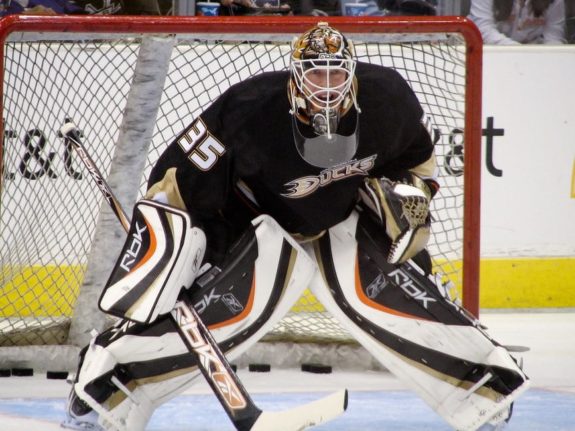
Giguere led Anaheim to two Stanley Cup Finals, the first in a losing effort, the second in a winning effort. He dominated during both playoff runs, but his 2003 performance in a seven-game series defeat to the New Jersey Devils became the stuff of legend. He posted a .945 save percentage and a microscopic 1.62 goals-against average in 21 games.
Without Giguere, the Ducks wouldn’t have sniffed the final, let alone pushed it to seven games. He is still one of only five players to win the Conn Smythe Trophy, for the playoffs’ most valuable player, in a loss. He is also the last to do so. He played so well that his performance in the 2003 loss overshadowed his performance in 2007 when he backstopped the Ducks to their first title in franchise history.
Calgary Sends Anaheim Another Piece of the Puzzle
Nearly three years later, Calgary and Anaheim combined for another important trade that helped build the Ducks’ 2007 team in two significant ways. It happened on March 11, 2003, with a deadline trade that sent Rob Niedermayer to the Ducks in exchange for Mike Commodore and Jean-Francoise Damphousse.
The Flames and general manager Craig Button wanted to relieve themselves of Niedermayer’s contract and collect young players for the future (which turned out to be the following season.)
Commodore had a successful career, compiling over 500 NHL regular season and playoff games. He played in the Flames’ 20 playoff games on their run to the final in 2004, which were more than his 18 regular-season games. Damphousse failed to crack the NHL after the trade.
On the flip side, the Ducks received a reliable third-line center who spent five full seasons in Anaheim. Niedermayer contributed 10 playoff points in both the Ducks 2003 and 2007 Stanley Cup runs, including five goals in the latter.
His contribution off the ice on the team’s roster played a significant role as well. Rob helped Ducks’ general manager Brian Burke sell his brother Scott Niedermayer on signing in Anaheim as a free agent in 2005.

Scott helped lead the Ducks to the 2007 Stanley Cup title, winning the Conn Smythe along the way.
No. 3 Winnipeg (Arizona) Sends a Franchise Great
Ducks fans can thank the old Winnipeg Jets, who are now the Arizona Coyotes, for jump-starting their favorite franchise. Besides their 2007 championship, the Selanne trade from Winnipeg to Anaheim might be the second most significant moment in franchise history. Since then, there have been other trades that have cemented their legacy as a strong trade partner for the Ducks.
Let’s get the most obvious trade out of the way first. Feb. 7, 1996, is a date Ducks fans should always remember. On that day, the Jets, who moved to Phoenix, Arizona soon after, sent Selanne to the Ducks with Marc Chouinard and a 1996 fourth-round pick. In exchange, Winnipeg received Chad Kilger, Oleg Tverdovsky, and a 1996 third-round selection.
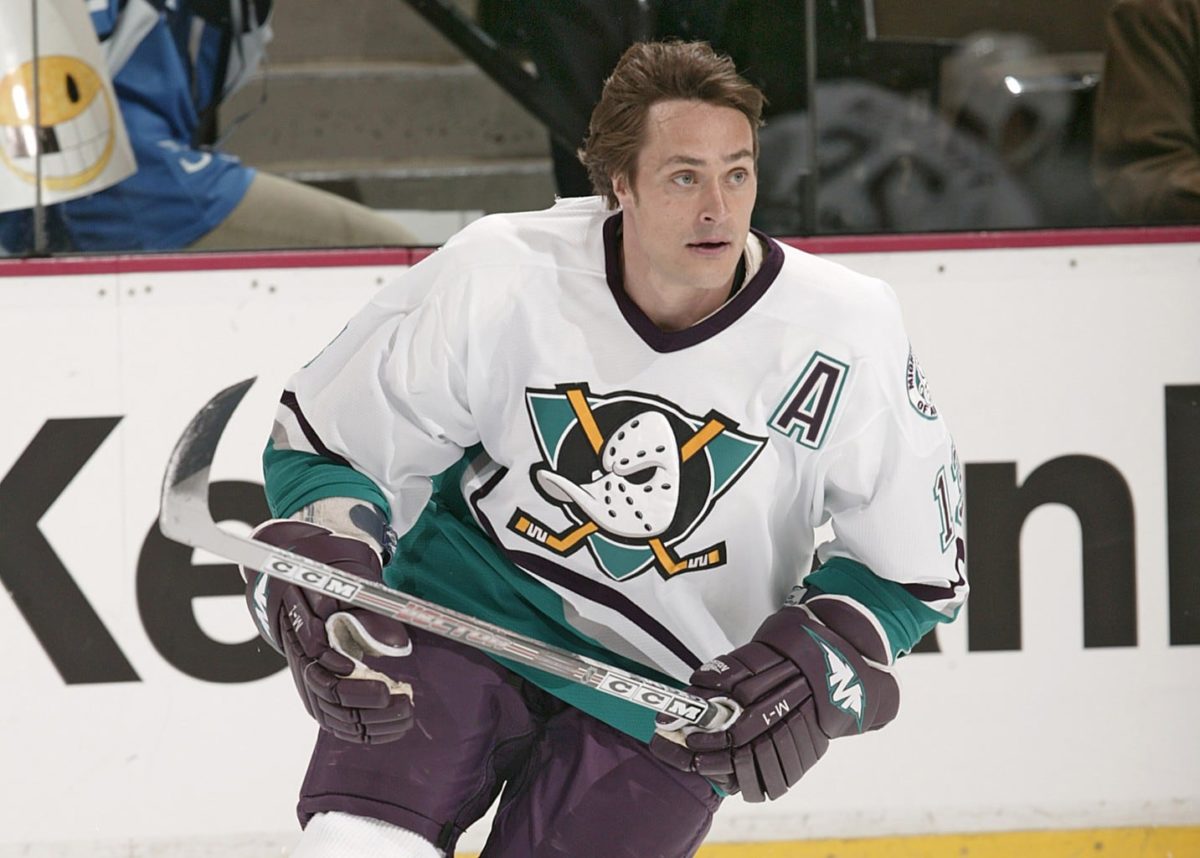
Kilger and Tverdovsky would have productive NHL careers (more on Tverdovsky in a moment), but Selanne was the prize. The young Finn had already accomplished a lot in his short career, most notably breaking the rookie goal-scoring record by potting 76 goals in 1992-93.
A Happy Surprise for Anaheim
Though the Jets’ owners told Selanne they wouldn’t trade him, they went through with it anyway. Former Jets’ general manager John Paddock told ESPN it came down to a combination of Selanne’s big contract, other large contracts already on the books for Winnipeg, injury concerns, and a need on defense.
Selanne joined a Ducks team who needed another star to pair with Kariya, and it worked. He helped the team qualify for the playoffs for the first time in their history in 1996-97 and again in 1998-99.
Though Selanne left Anaheim in another trade and then returned as a free agent, his first stint there helped him make his decision to return and eventually helped the Ducks to their 2007 title.
He told ESPN in 2005,
“I’m very excited to be back in Anaheim. I have such great memories from there. I’m looking forward to having many more. You never know in this business where you’re going to be. I had a feeling I was going to come back.”
It wasn’t just Selanne that came back to Anaheim.
The Return of Tverdovsky
Although Selanne changed the Ducks’ fortunes, the loss of Tverdovsky on defense stung a little. The No. 2 overall pick in the 1994 Draft made an impact as soon as he saw the ice for the Ducks, amassing 34 points in 87 games before they sent him to Winnipeg in the Selanne trade.
Tverdovsky had moments of success in Winnipeg and then Phoenix. His 107 points in 241 regular-season games helped the team qualify for the playoffs every season he played there. But Tverdovsky’s time in Phoenix, like his exit from Anaheim, had been tumultuous.
After Anaheim and Winnipeg made their trade, Tverdovsky revealed that his mother had been kidnapped and held for ransom by one of his former minor hockey coaches, who had affiliations with Russian organized crime. Russian authorities rescued her, but that might have affected his first memories in Anaheim.
He also criticized his former coach with the Ducks, Ron Wilson, after the trade and said he “hated” his former team. Then he held out to start the 1997 season in Phoenix. He allegedly had altercations with Coyotes’ stars Jeremy Roenick and Keith Tkachuk, and on top of that, his production had dipped.
Shocked and Thrilled
When news of his 1999 Draft-day trade broke, it was not a surprise given Tverdovsky’s behavior in Phoenix, but very odd that he had returned to Anaheim. So much so he told the LA Times,
“My agent started telling me I’ve been traded to the Ducks,” Tverdovsky said recently from Moscow. “I said, ‘Are you playing a joke on me?’ When my head cleared, I understood, and I was thrilled.”
The Ducks sent the Coyotes Travis Green and their first-round pick in the draft.
Tverdovsky’s production returned when he got back to Anaheim, and he broke the 50-point barrier both of his next two seasons before dropping to 32 points in 2001-02.
On the Coyotes side, their No. 15 overall pick never cracked the NHL, but Green remained productive. He placed third on the team in scoring during his first season in Phoenix and then seventh on the team in his second season.
Green eventually returned to Anaheim in 2006 before the team put him on waivers after only seven games.
No. 2 Maple Leafs Make Major Impact on Ducks
Though the trade history between the Ducks and Toronto Maple Leafs hasn’t helped Anaheim build a title contender yet, the sheer number of recent trades and their impact on the Ducks’ roster is significant.
The two teams have combined for over 20 trades in 26 seasons, some coming within days of each other. Many of the best transactions between the Ducks and Maple Leafs occurred within the last decade, and three came within six months of each other in 2011.
The first occurred Feb. 9, 2011, when Anaheim sent Joffrey Lupul, Jake Gardiner, and a conditional 4th round pick to Toronto for Francois Beauchemin. Though the trade might be considered a loss for the Ducks, it still brought back Beauchemin, who played a valuable role in his return to Anaheim.
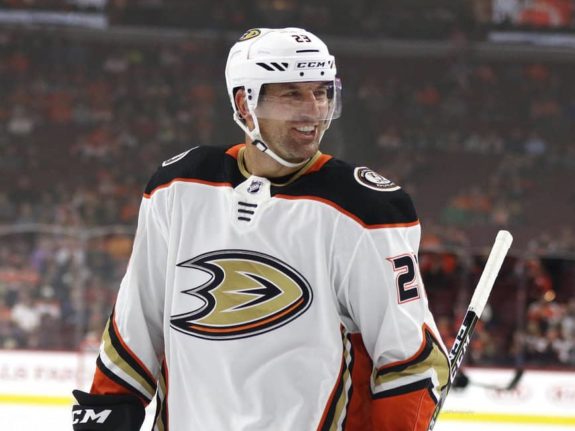
Lupul had a productive start to his time in Toronto. He scored 18 points in his first 28 games with the team. The next year he produced a career-high 67 points for the Maple Leafs before struggling with injury problems over the rest of his career.
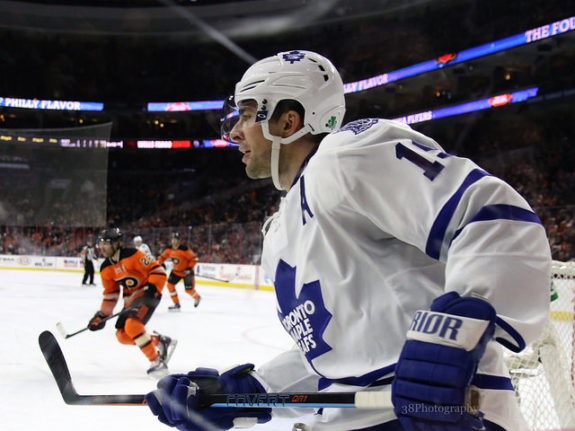
Jake Gardiner never played a game for Anaheim, the team that drafted him, but went on to have a strong career that continues today. Though he became the whipping boy in Toronto, he has consistently produced 30-plus point seasons. The Maple Leafs traded away the fourth-round pick.
A Helpful Relationship
With the acquisition of Beauchemin, Ducks’ general manager Bob Murray looked to solidify their defense, which included a young Cam Fowler, with a proven veteran who had won with the Ducks.
Perhaps it makes sense that a trade between Murray and Burke, his former boss with the Ducks, involved Beauchemin. Of the trade between him and his former protégé, Burke said,
“I’d say it was kind of simultaneous more than anything,” Burke told reporters in Toronto. “I said, ‘Look at the ice time Lupul’s getting now that he’s healthy. Is he a guy you might move?’ Bob Murray said, ‘Only if Beauchemin’s involved.’ Or I might have it backwards.”
(from Beauchemin back in, Lupul back out for Ducks,‘ The Los Angeles Daily News – 2/9/2011)
Though the team suffered an early exit from the playoffs that season, the Ducks made the postseason three out of Beauchemin’s next four years in Anaheim. That included a nine-assist performance on the way to the conference final in 2014-15.
Draft Wizardry
The next two trades occurred later that summer during the 2011 NHL Draft. That’s when Murray traded the Ducks’ No. 22 overall to Toronto for the No. 30 overall pick the Maple Leafs had acquired from Boston and Toronto’s second-round pick.
With those two selections, the Ducks picked franchise goalie John Gibson and first-line forward Rickard Rakell. Murray’s wheeling and dealing with Toronto continued on Day Two of the draft when he traded Anaheim’s 2012 sixth-round pick for Toronto’s 2011 sixth-rounder. They used that pick to select Josh Manson.
Another and perhaps equally important exchange came in the days leading up to the 2016 Draft. That’s when Murray traded goaltender Frederik Andersen to the Maple Leafs for their 2016 first-round pick and their 2017 second-round pick. Those two picks became Sam Steel and Max Comtois.
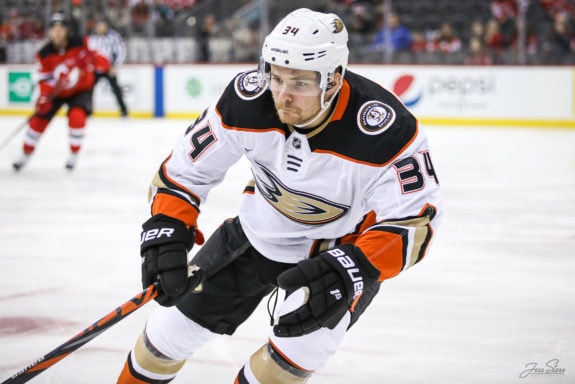
Though the Ducks’ recent trades with Toronto didn’t help build a title-contending team yet, they have yielded productive NHL players, a franchise goalie, and perhaps some young, future trade chips to help the team pursue their second Stanley Cup.
No 1: Edmonton Pushes Anaheim Over the Top
The Edmonton Oilers and Ducks might not have executed a large number of trades between the two of them during their combined time in the NHL, but the Oilers have been part of three that have helped the Ducks.
The most historic came on July 3, 2006. On that day, Ducks’ general manager Burke acquired franchise defenseman Chris Pronger from the Oilers.
The Ducks had made the Stanley Cup Final just over three years before and continued to contend, losing in the conference final in 2005-06. They just needed that last piece to get the job done, and they found it in Pronger. The combined power of he and Scott Niedermayer made the Ducks a contender.
Though Pronger requested a trade, the Ducks paid a significant price to acquire him, which all proved worth it in the end.
In exchange for Pronger, they sent the Oilers Lupul, who had already flirted with a 30-goal season in 2005-06 as a 22-year-old. The Ducks also parted with their 2007 first-round pick, their 2008 second-round pick, and a 2008 conditional first-round pick, which the Oilers received once the Ducks made the 2007 final.
All Pronger did in the 2006-07 season was contribute 59 points in the regular season and 15 in the playoffs. He and 2007 Conn Smythe Trophy winner Scott Niedermayer combined to give Anaheim the league’s seventh-best mark in goals against and fifth-best in shots against.
Without the Pronger trade, the Ducks might still be without a Stanley Cup.
Visnovsky In, Whitney Out
Edmonton continued sending Anaheim defensemen. The March 3, 2010, trade deadline deal that sent Ryan Whitney and a sixth-round pick in the 2010 Draft to Edmonton in exchange for Lubomir Visnovsky came out incredibly one-sided.
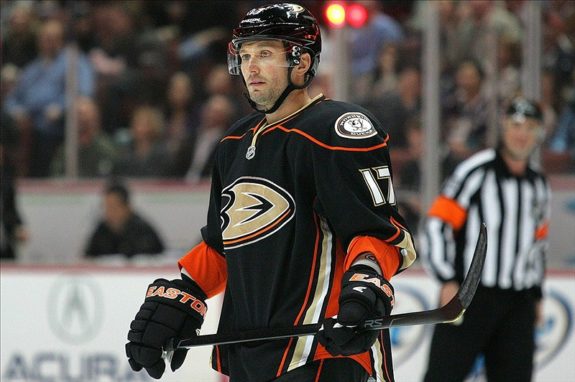
Whitney had been a consistent point producer on the Penguins’ blue line before arriving in Anaheim. His stint in Orange County only lasted 95 combined regular season and playoff games over two seasons. During that time, he amassed 44 points but didn’t live up to what Murray hoped he could achieve.
So, come the 2010 Trade Deadline, Whitney found himself on the move again. It proved to be a well-timed trade for the Ducks. Visnovsky managed nearly a point per game to finish the 2009-10 season in Anaheim, though he broke his hand to close it out. In 2010-11, he exploded for a career-high 68 points, including 18 goals. His final season in Anaheim was hampered by injury, including a hand injury that damaged his ability to produce. Still, in parts of three seasons, Visnovsky was a significant net gain when compared to Whitney.
Though Whitney produced with the Oilers, his injury problems limited him to 92 games over three seasons. All three seasons saw the Oilers miss the playoffs before he left for a brief stint with the Florida Panthers.
In Comes the Iron Man
The most recent notable trade between the Ducks and Oilers came in the Summer of 2011 when Murray traded a second-round pick in the 2013 Draft for young centerman Andrew Cogliano.
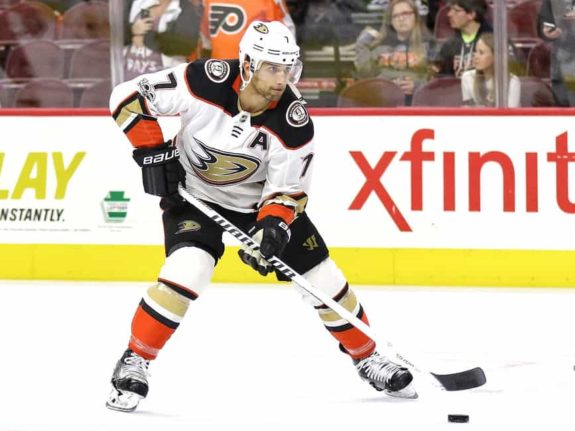
Cogliano had been a first-round pick in the 2005 NHL Draft. Over four full seasons with the Oilers, Cogliano consistently produced. His first two seasons saw him score 18 goals and top 35 points. Though his production declined in his final years with the Oilers, it still wasn’t terrible.
The Ducks needed a strong third-line center, which is precisely what they got without surrendering very much. Cogliano played six full seasons in Anaheim, becoming a fan favorite while playing 830 consecutive games, the fourth-most in NHL history. That streak ended in controversy in 2018 when the league suspended him two games for what they deemed a dangerous hit.
Cogliano solidified the third line as Murray had hoped, managing roughly 30-points per season in Anaheim. Meanwhile, the Ducks had another second-round pick in 2013.
Honorable Mention: Boston Bruins and New Jersey Devils
The Boston Bruins could be on this list come 2030.
The two 2020 Trade Deadline moves between the Ducks and Bruins are still fresh and will need some time to realize their effect on both teams. Nick Ritchie’s time in Boston hasn’t been what the Bruins hoped for, and unless he finally realizes the potential the Ducks and Bruins saw in him in 2020-21, you can bet he won’t be in Boston much longer.
Ondrej Kase also failed to produce on the score sheet in Boston as he had once done in Anaheim. In the remainder of the 2019-20 regular season and the playoffs, Kase managed only five assists in 18 games.
Meanwhile, the Ducks were able to draft Jacob Perreault at No. 27 in the 2020 Draft with the pick they got for trading Kase and taking David Backes and part of his contract in return. They also received Axel Andersson, a former second-round pick for the Bruins, who looks to be a potential depth defenseman.
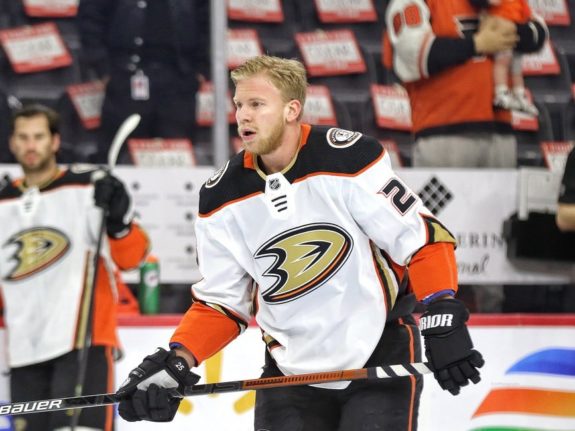
In the Ritchie trade, the Ducks received young forward Danton Heinen, who is only 25 years old and notched 47 points in his first full NHL season in 2017-18. Since then, he competed for ice time in a crowded and talented Bruins’ forward corps until the Bruins traded him. During his first nine games in Anaheim before the COVID-19 pandemic, Heinen scored three goals and added an assist. If the Ducks can get back into contention in the next few seasons, Perreault, Heinen, and Andersson may be part of the reason.
Dancing With the Devils
The New Jersey Devils deserve honorable mention in this article as well. They didn’t make the top five primarily because they’ve made several big trades with the Ducks that Anaheim did benefit from but also came back to bite them.
In one of those trades, the Ducks sent Sami Vatanen and a conditional third-round pick to New Jersey for Adam Henrique, Joseph Blandisi and a 2018 third-round pick. The third-rounder became forward Blake McLaughlin, who is entering his junior season at the University of Minnesota. Blandisi played six NHL games for Anaheim before Murray traded him to Pittsburgh. Henrique ended up being the best piece of the trade. The versatile center has been a consistent producer and led the team with 26 goals and 43 points during the 2019-20 season.
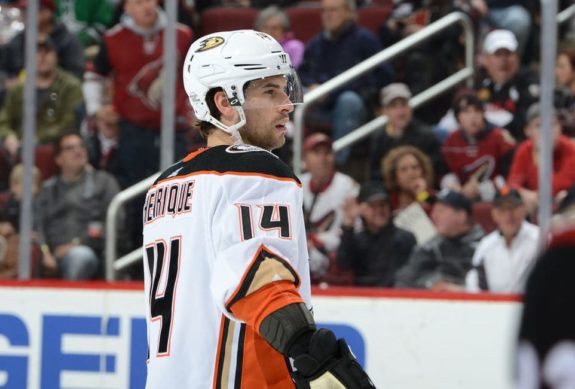
Unfortunately, soon after the trade, it became clear that the Ducks could’ve used Vatanen. Anaheim’s defense went from a significant strength with Vatanen and Brandon Montour complimenting Fowler, Hampus Lindholm, and Josh Manson, to a weakness that Anaheim still hasn’t totally fixed.
Friesen Freezes Ducks
Then there’s the July 6, 2002 trade between the Devils and Ducks that sent Jeff Friesen, Tverdovsky, and Maxim Balmochnykh to New Jersey for Commodore, Damphousse, and Petr Sykora.
Commodore never cracked the Ducks’ lineup before landing in Calgary in the Niedermayer trade, and Damphousse never saw the NHL after his move to Anaheim. Still, Sykora was a significant plus for the Ducks. He was second in scoring during the 2002-03 season behind Kariya, with 34 goals and 25 assists for 59 points. Sykora tallied 13 playoff points on the way to the Ducks’ appearance against his old team, the Devils, in the 2003 Final. Two of those 13 points were overtime winners, and five came in the final.
The players the Ducks traded away would haunt them in that very final. Friesen scored five goals against his old team, including two in a 3-0 win in the deciding seventh game. Tverdovsky, who only spent that season in New Jersey, added two assists in the final.
Over the past 26 seasons, the Ducks have gone through six general managers. That means that successful trades with one team over that time aren’t as much of a trend as they are a coincidence. Still, relationships like the one between Burke and Murray can help increase activity during specific periods. All of the teams on this list have helped monumentally change the Ducks franchise, from adding Hockey Hall of Famers and championship pieces to fan favorites and assets. Keep an eye out for activity with these teams in the future.
All stats from nhltradetracker.com, hockey-reference.com, and capfriendly.com